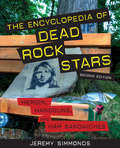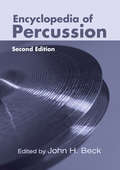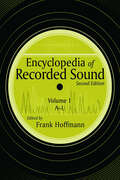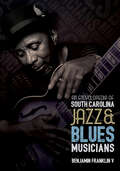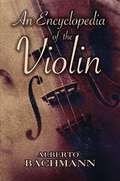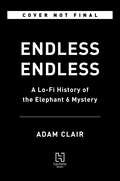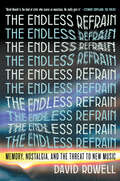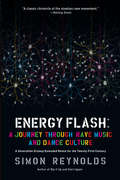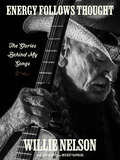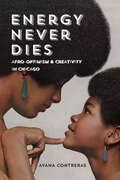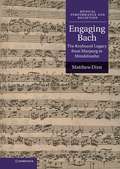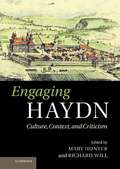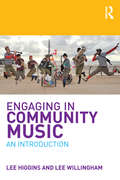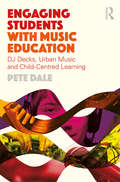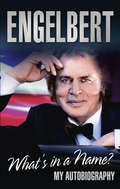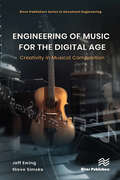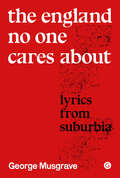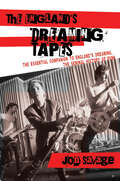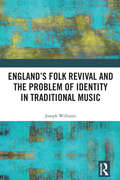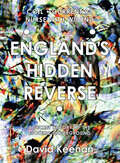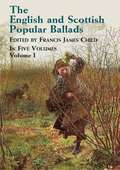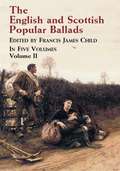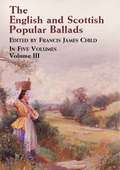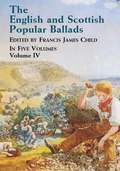- Table View
- List View
The Encyclopedia of Dead Rock Stars: Heroin, Handguns, and Ham Sandwiches
by Jeremy SimmondsThe bible of music's deceased idols--Jeff Buckley, Sid Vicious, Jimi Hendrix, Tupac, Elvis--this is the ultimate record of all those who arrived, rocked, and checked out over the last 40-odd years of fast cars, private jets, hard drugs, and reckless living. The truths behind thousands of fascinating stories--such as how Buddy Holly only decided to fly so he'd have time to finish his laundry--are coupled with perennial questions, including Which band boasts the most dead members? and Who had the bright idea of changing a light bulb while standing in the shower?, as well as a few tales of lesser-known rock tragedies. Updated to include all the rock deaths since the previous edition--including Ike Turner, Dan Fogelberg, Bo Diddley, Isaac Hayes, Eartha Kitt, Michael Jackson, Clarence Clemons, Amy Winehouse, and many, many more--this new edition has been comprehensively revised throughout. An indispensable reference full of useful and useless information, with hundreds of photos of the good, the bad, and the silly, this collection is guaranteed to rock the world of trivia buffs and diehards alike.
The Encyclopedia of Disc Music Boxes 1881-1920: A History, Catalog Raisonné, and Appreciation
by Q. David BowersDisc Music Boxes preceded the phonograph as a way of listening to popular tunes and classical music. They were located in private homes and public places of entertainment. This is an extensive encyclopedia for collectors of these disc music boxes. The DAISY version is considerably indexed for easy navigation.
Encyclopedia of Percussion
by John H. BeckThe Encyclopedia of Percussion is an extensive guide to percussion instruments, organized for research as well as general knowledge. Focusing on idiophones and membranophones, it covers in detail both Western and non-Western percussive instruments. These include not only instruments whose usual sound is produced percussively (like snare drums and triangles), but those whose usual sound is produced concussively (like castanets and claves) or by friction (like the cuíca and the lion’s roar). The expertise of contributors have been used to produce a wide-ranging list of percussion topics. The volume includes: (1) an alphabetical listing of percussion instruments and terms from around the world; (2) an extensive section of illustrations of percussion instruments; (3) thirty-five articles covering topics from Basel drumming to the xylophone; (4) a list of percussion symbols; (5) a table of percussion instruments and terms in English, French, German, and Italian; and (6) an updated section of published writings on methods for percussion.
Encyclopedia of Recorded Sound
by Frank Hoffmann Howard FerstlerFirst Published in 2005. The Encyclopedia of Recorded Sound, 2nd edition, is an A to Z reference work covering the entire history of recorded sound from Edison discs to CDs and MP3. Entries range from technical terms (Acoustics; Back Tracking; Quadraphonic) to recording genres (blues, opera, spoken word) to histories of industry leaders and record labels to famed recording artists (focusing on their impact on recorded sound). Entries range in length from 25-word definitions of terms to 5000 word essays. Drawing on a panel of experts, the general editor has pulled together a wealth of information. The volume concludes with a complete reference bibliography and a deep index.
An Encyclopedia of South Carolina Jazz & Blues Musicians
by Benjamin Franklin VThis comprehensive A-to-Z reference is “an impressive contribution to jazz history and surprisingly good reading” (Michael Ullman, author of Jazz Lives).This informative bookdocuments the careers of South Carolina jazz and blues musicians from the nineteenth century to the present. The musicians range from the renowned (James Brown, Dizzy Gillespie), to the notable (Freddie Green, Josh White), the largely forgotten (Fud Livingston, Josie Miles), the obscure (Lottie Frost Hightower, Horace “Spoons” Williams), and the unknown (Vince Arnold, Johnny Wilson).Though the term “jazz” is commonly understood, if difficult to define, “blues” has evolved over time to include R&B, doo-wop, and soul. Performers in these genres are also represented, as are members of the Jenkins Orphanage bands of Charleston. Also covered are nineteenth-century musicians who performed what might be called proto-jazz or proto-blues in string bands, medicine shows, vaudeville, and the like.Organized alphabetically, from Johnny Acey to Webster Young, the entries include basic biographical information, South Carolina residences, career details, compositions, recordings as leaders and as band members, films, awards, websites, and lists of resources for additional reading. Former host of Jazz in Retrospect on NPR Benjamin Franklin V has ensured biographical accuracy to the greatest degree possible by consulting numerous public documents, and information in these records permitted him to dispel myths and correct misinformation that have surrounded South Carolina’s musical history for generations.“Elucidates South Carolina as a profoundly crucial puzzle piece alongside New Orleans, Chicago, Kansas City and New York.” —Harry Skoler, professor, Berklee College of MusicIncludes photos
An Encyclopedia of the Violin (Dover Books on Music)
by Alberto Bachmann"No list of twentieth-century landmarks in music reference would be valid without Bachmann's Encyclopedia."--American Reference Book Annual"If there were such an award as one for the best reprint of our day, surely this book by Alberto Bachmann would be way up front with the leaders."--American String TeacherOf the many books written about the violin, none offers the breadth and scope of this renowned reference. First published in 1925, it remains unsurpassed as a source of essential information on all aspects of the instrument. It traces the evolution of technique from the 1800s onward, in addition to examining the violin's construction and manufacture, listing American and European makers, and offering a biographic section on chamber music ensembles.Seventy-three rare photographs complement the text, which features an introduction by the legendary violinist Eugène Ysaÿe and a glossary of music and musical terms. Written by a concert violinist and composer, this remarkable handbook is a must for professionals, amateurs, teachers, and students.
Endless Endless: A Lo-Fi History of the Elephant 6 Mystery
by Adam ClairAn inspiring, revelatory exploration of the genesis and impact of the fabled Elephant 6 collective and the baffling exodus of its larger-than-life luminary, Neutral Milk Hotel frontman Jeff Mangum Years after its release, Neutral Milk Hotel&’s In the Aeroplane Over the Sea remains one of the most beloved and best-selling albums in all of indie music, hailed as a classic so influential as to be almost synonymous with the ongoing vinyl revival. But despite its outsized impact, a question looms even larger: why did frontman Jeff Mangum, just as the record propelled him to the brink of music superstardom, choose instead to disappear entirely? The mystery has perplexed listeners for decades—until now. In barely two years, Neutral Milk Hotel rose from house show obscurity in Athens, Georgia, to widespread hype and critical acclaim, selling out rock clubs across the country and gracing the tops of numerous year-end best-of lists. But just as his band was reaching the escape velocity necessary to ascend from indie rock success to mainstream superstar, Mangum hit the eject button. After the 1998 release of Aeroplane and a worldwide tour to support it, Mangum stopped playing shows, releasing new music, or even doing interviews. He never explained why, not even to his friends or colleagues, but thanks to both the strength of Aeroplane and his vexing decision to walk away from rock stardom, Neutral Milk Hotel&’s impact only grew from there. In Endless Endless, Adam Clair finds the answer to indie rock&’s biggest mystery, which turns out to be much more complicated and fascinating than the myths or popular speculation would have you believe. To understand Mangum and Neutral Milk Hotel and Aeroplane requires a deep dive into the unconventional inner workings of the mercurial collective from which they emerged, the legendary Elephant 6 Recording Company. Endless Endless details the rise and fall of this radical music scene, the lives and relationships of the artists involved and the colossal influence that still radiates from it, centered around the collective&’s accidental figurehead, one of the most idolized and misunderstood artists in the world, presenting Mangum and his collaborators in vividly human detail and shining a light into the secret world of these extraordinary and aggressively bizarre artists. Endless Endless offers unprecedented access to this notoriously mysterious collective, featuring more than 100 new interviews and dozens of forgotten old ones, along with never-before-seen photos, answering questions that have persisted for decades while also provoking new ones. In this deeply researched account, Endless Endless examines not just how the Elephant 6 came to be so much more than the sum of its parts, but how community can foster art—and how art can build community.
The Endless Refrain: Memory, Nostalgia, and the Threat to New Music
by David RowellA veteran music journalist argues that the rise of music streaming and the consolidation of digital platforms is decimating the musical landscape, with dire consequences for the future of our culture …In The Endless Refrain, former Washington Post writer and editor David Rowell lays out how commercial and cultural forces have laid waste to the cultural ecosystems that have produced decades of great American music. From the scorched-earth demonetizing of artist revenue accomplished by Spotify and its ilk to the rise of dead artists &“touring&” via hologram, Rowell examines how a perfect storm of conditions have drained our shared musical landscape of vitality.Combining personal memoir, intimate on-the-ground reporting, industry research, and cultural criticism, Rowell&’s book is a powerful indictment of a music culture gone awry, driven by conformity and subverted by the ways the internet and media influence what we listen to and how we listen to it.
Energy Flash: A Journey Through Rave Music and Dance Culture
by Simon ReynoldsEcstasy did for house music what LSD did for psychedelic rock. Now, in Energy Flash, journalist Simon Reynolds offers a revved-up and passionate inside chronicle of how MDMA ("ecstasy") and MIDI (the basis for electronica) together spawned the unique rave culture of the 1990s.England, Germany, and Holland began tinkering with imported Detroit techno and Chicago house music in the late 1980s, and when ecstasy was added to the mix in British clubs, a new music subculture was born. A longtime writer on the music beat, Reynolds started watching-and partaking in-the rave scene early on, observing firsthand ecstasy's sense-heightening and serotonin-surging effects on the music and the scene. In telling the story, Reynolds goes way beyond straight music history, mixing social history, interviews with participants and scene-makers, and his own analysis of the sounds with the names of key places, tracks, groups, scenes, and artists. He delves deep into the panoply of rave-worthy drugs and proper rave attitude and etiquette, exposing a nuanced musical phenomenon.Read on, and learn why is nitrous oxide is called "hippy crack."
Energy Follows Thought: The Stories Behind My Songs
by Willie Nelson David Ritz Mickey RaphaelRevealing, funny, whimsical, and wise, outlaw country legend Willie Nelson shares the untold stories behind the his favorite songs, with all the lyrics and a dynamic assortment of never-before-seen photos and ephemera.From his earliest work in the 1950s to today, Willie looks back at the songs that have defined his career, from his days of earning $50 each to his biggest hits, from his less well-known songs (but incredibly meaningful to him) to his concept albums. Along the way, he also shares the stories of his guitar Trigger, his family and “family,” as well as the artists he collaborated with, including Patsy Cline, Waylon Jennings, Ray Charles, Merle Haggard, Ray Price, Dolly Parton, and many others.Willie is disarmingly honest—what do you have to lose when you’re about to turn 90? —meditating on the nature of songwriting and finding his voice, and the themes he’s explored his whole life—relationships, infidelity, love, loss, friendship, and, of course, life on the road.
Energy Never Dies: Afro-Optimism and Creativity in Chicago
by Ayana ContrerasFrom Afro Sheen to Theaster Gates and from Soul Train to Chance the Rapper, Black Chicago draws sustenance from a culture rooted in self-determination, aspiration, and hustle. In Energy Never Dies, Ayana Contreras embarks on a journey to share the implausible success stories and breathtaking achievements of Black Chicago's artists and entrepreneurs. Past and present generations speak with one another, maintaining a vital connection to a beautiful narrative of Black triumph and empowerment that still inspires creativity and pride. Contreras weaves a hidden history from these true stories and the magic released by undervalued cultural artifacts. As she does, the idea that the improbable is always possible emerges as an indestructible Afro-Optimism that binds a people together. Passionate and enlightening, Energy Never Dies uses the power of storytelling to show how optimism and courage fuel the dreams of Black Chicago.
Engaging Bach
by Matthew DirstMore than any other part of Bach's output, his keyboard works conveyed the essence of his inimitable art to generations of admirers. The varied responses to this repertory – in scholarly and popular writing, public lectures, musical composition and transcription, performances and editions – ensured its place in the canon and broadened its creator's appeal. The early reception of Bach's keyboard music also continues to affect how we understand and value it, though we rarely recognize that historical continuity. Here, Matthew Dirst investigates how Bach's music intersects with cultural, social and music history, focusing on a repertory which is often overshadowed in scholarly and popular literature on Bach reception. Organized around the most productive ideas generated by Bach's keyboard works from his own day to the middle of the nineteenth century, this study shows how Bach's remarkable and long-lasting legacy took shape amid critical changes in European musical thought and practice.
Engaging Haydn: Culture, Context, and Criticism
by Mary Hunter Richard WillHaydn is enjoying renewed appreciation as one of the towering figures of Western music history. This lively collection builds upon this resurgence of interest, with chapters exploring the nature of Haydn's invention and the cultural forces that he both absorbed and helped to shape and express. The volume addresses Haydn's celebrated instrumental pieces, the epoch-making Creation and many lesser-known but superb vocal works including the Masses, the English canzonettas and Scottish songs and the operas L'isola disabitata and L'anima del filosofo. Topics range from Haydn's rondo forms to his violin fingerings, from his interpretation of the Credo to his reading of Ovid's Metamorphoses, from his involvement with national music to his influence on the emerging concept of the musical work. Haydn emerges as an engaged artist in every sense of the term, as remarkable for his critical response to the world around him as for his innovations in musical composition.
Engaging in Community Music: An Introduction
by Lee Higgins Lee WillinghamEngaging in Community Music: An Introduction focuses on the processes involved in designing, initiating, executing and evaluating community music practices. Designed for both undergraduate and graduate students, in community music programmes and related fields of study alike, this co-authored textbook provides explanations, case examples and ‘how-to’ activities supported by a rich research base. The authors have also interviewed key practitioners in this distinctive field, encouraging interviewees to reflect on aspects of their work in order to illuminate best practices within their specialisations and thereby establishing a comprehensive narrative of case study illustrations. Features: a thorough exploration and description of the emerging field of community music; succinctly and accessibly written, in a way in which students can relate; interviews with 26 practitioners in the US, UK, Australia, Europe, Canada, Scandinavia and South Africa, where non-formal education settings with a music leader, or facilitator, have experienced success; case studies from many cultural groups of all ages and abilities; research on life-long learning, music in prisons, music and ritual, community music therapy, popular musics, leisure and recreation, business and marketing strategies, online communities – all components of community music.
Engaging Students with Music Education: DJ decks, urban music and child-centred learning
by Pete DaleEngaging Students with Music Education is a groundbreaking book about using DJ decks and urban music in mainstream schools to re-engage disaffected learners and develop a curriculum which better reflects overall contemporary tastes. Many young learners are ‘at risk’ of exclusion; this book argues that for such individuals, the implications of such a shift in the music curriculum could be especially positive. Drawing extensively on the author’s own wealth of teaching experience, and bridging the gap between practice and theory, this book demonstrates through case studies that DJ decks can prove extremely valuable in mainstream classroom situations across the secondary school age ranges. Addressing challenging and crucial topics, combining rigorous theoretical analysis with practical suggestions, the book addresses questions such as: Are DJ decks actually a musical instrument, and are they suitable for classroom teaching? Will Ofsted's school inspectors approve of music teaching involving DJ decks and urban music? If we bring urban music into the classroom, will this further marginalise classical music? Are DJing and MCing skills recognised within examination specifications, at least in the UK? Current teachers will find the practical advice on how to incorporate DJ decks and urban music into their classroom especially helpful, whilst educational researchers will be captivated by the critical discussion of the child-centred tradition and a theoretical approach which stretches from ‘continental’ philosophy to practice-based reflection. With an insistence that the starting point for music education should always be the interests and experiences of the learners, this book is essential reading for those music teachers and researchers interested in the benefits of non-standard music-making in the classroom.
Engelbert - What's In A Name?: My Autobiography
by Engelbert HumperdinckThe man known simply as 'Enge' by his millions of fans worldwide has sold over 150 million records and is in the Guinness Book of Records for achieving 56 consecutive weeks in the chart with 'Release Me'.From living on the dole and receiving last rites with tuberculosis, to buying a Hollywood palace with a heart-shaped pool and a fleet of fourteen Rolls Royces, Engelbert wears his 'King of Romance' crown so well that horticulturists even named a rose after him. And the love god has certainly lived up to his reputation, indulging in a string of affairs and one-night stands, whilst remaining happily married to his first love Patricia. Forty years on from his early hits 'Enge' is still at the very top, selling out concerts across the world, representing the UK at the 2012 Eurovision Song Contest, and topping the charts in all the major markets.Inspired by the warmth of his millions of affectionate fans and the endless support of his wife, Engelbert shares his incredible life story with openness, humour and astonishing honesty.
Engineering of Music for the Digital Age: Creativity in Musical Composition
by Jeffrey Ewing Steven SimskeMusical scores – like literature, poetry, and technical manuals – are documents. The central tenet of this book is that musical composition in the digital age is a form of document engineering. In essence, music shares with other forms of creative content generation – from poetry to prose, and from science to science fiction – the need for structure, flow, and sources for creativity.Musical composition is considered in this book as the creative process of engineering musical documents with regards to its arrangement, form, texture, and instrumentation, etc. This "document" then instructs a performance or the creation of an alternative document, such as a recording. In this book, the arrangement of phrases, patterns, and structures seen in music will be illustrated to give new composers a starting point to begin planning and making decisions about their own compositions.The book will also guide those who need assistance in completing a piece. While this is a book about musical composition, it is not meant to be a manual on music theory. Instead, the book keeps its focus on the structural elements of a composition. Its aim is to give the audience a structural road map for composing; whether they are starting a piece from the first note, having a melody in mind already, or need help overcoming a creative hurdle. The book examines compositions that clearly define a form or technique. Among the key compositional elements are: Form, Phrase, Period, and Expression in Composition Rhythm/Motive Melody and Harmony Tonal Center Mode Mixture and Modulation Accompaniment/Instrumentation/Orchestration Composition Techniques and Notation Targeted examples cover all stages of writing a piece, helping to build the reader’s composition from the first note into a complete work without promoting a style or harmonic practice. Each chapter contains a sidebar addressing helping the composer to add creative sources for the music making process. Finally, the book concludes with a chapter on creativity in terms of how composed music can affect our lives and even our fairy tales.
The England No One Cares About: Lyrics from Suburbia (Goldsmiths Press / Sonics Series)
by George MusgraveAn exploration of the much-derided English suburbs through rap music.There are many different Englands. From the much-romanticized rolling countryside, to the cosmopolitanism of the inner cities (embraced by some as progressive, multicultural enlightenment and derided by others as the playground of a self-righteous metropolitan elite), or the disparagingly named "left behind" communities which, post-Brexit, have so interested political parties and pundits, demographers and statisticians.But there is also an England no one cares about. The England of semi-detached houses and clean driveways for multiple cars devotedly washed on Sundays, of "twitching curtains" and Laura Ashley sofas; of cul-de-sacs to nowhere and exaggerated accents; of late night drives to petrol stations on A roads, fake IDs tested in Harvesters, and faded tracksuits and over-gelled hair in Toby Carverys; of questionable hash from a "mate of a mate" and two-litre bottles of White Lightning from Budgens consumed in a kids playground. Much derided. Unglamorous, ordinary; cultural vacuity and small "c" conservatism. A hodgepodge. An—apparently—middling, middle-of-the-road middle-England of middle-class middle-mindedness. Part poetry anthology, part academic study into placemaking, and part autoethnography, The England No One Cares About innovatively brings together academic discussions of the ethnographic potential of lyrics, scholastic representations of suburbia, and thematic analysis to explore how rap music can illuminate the experiences of young men growing up in suburbia. This takes place by exploring the author&’s own annotated lyrics from his career as a musician known as Context where he was referred to by the BBC as "Middle England&’s Poet Laureate."
The England's Dreaming Tapes
by Jon SavageJon Savage's 1991 book, England's Dreaming: Anarchy, Sex Pistols, Punk Rock, and Beyond, was hailed by the New York Times Book Review as "the definitive history of the English punk movement." Widely imitated but never equaled, it remains that rare work of music history that appeals to music fans, critics, and scholars alike. In researching England's Dreaming, Savage conducted hundreds of hours of interviews of which only a fraction made it into the finished book. Now, in The England's Dreaming Tapes, Savage makes available for the first time the full, uncut, sensational story behind the cultural moment that was punk.Here is the story of a generation that changed the world in just a few months in 1976, as told by the scene's major figures: all four original Sex Pistols as well as Joe Strummer, Chrissie Hynde, Jordan, Siouxsie Sioux, Viv Albertine, Adam Ant, Lee Black Childers, Howard Devoto, Pete Shelley, Syl Sylvain, Debbie Wilson, Tony Wilson, Jah Wobble, and many others. Together, they offer a sweeping history of the late 1960s and the 1970s-not just the era's music, but also its radical politics, social issues, fashion, and culture.An invaluable source of information about a movement that has become obscured by myth, these vivid, unvarnished interviews were conducted when punk was only a decade old. In many cases, this was the first time that the subjects had talked about the period. The interviews describe the founding of the Sex Pistols; 430 King's Road, site of the legendary boutique Sex, which helped establish the punk aesthetic; punk rock New York; the cultural landscapes of London and its suburbs; the writers who covered punk; and the Manchester music scene centered around Factory Records.With The England's Dreaming Tapes, Savage gives us the first and final word on the music, fashion, and attitude that defined this influential and incendiary era.
England’s Folk Revival and the Problem of Identity in Traditional Music
by Joseph WilliamsEstablishing an intersection between the fields of traditional music studies, English folk music history and the philosophy of Gilles Deleuze and Félix Guattari, this book responds to the problematic emphasis on cultural identity in the way traditional music is understood and valued. Williams locates the roots of contemporary definitions of traditional music, including UNESCO-designated intangible cultural heritage, in the theory of English folk music developed in 1907 by Cecil Sharp. Through a combination of Deleuzian philosophical analysis and historical revision of England’s folk revival of the Victorian and Edwardian eras, Williams makes a compelling argument that identity is a restrictive ideology that runs counter to the material processes of traditional music’s production. Williams reimagines Sharp’s appropriation of Darwinian evolutionary concepts, asking what it would mean today to say that traditional music ‘evolves’, in light of recent advances in evolutionary theory. The book ultimately advances a concept of traditional music that eschews the term’s long-standing ontological and axiological foundations in the principle of identity. For scholars and graduate students in musicology, cultural studies, and ethnomusicology, the book is an ambitious and provocative challenge to entrenched habits of thought in the study of traditional music and the historiography of England’s folk revival.
England's Hidden Reverse, revised and expanded edition: A Secret History of the Esoteric Underground
by David KeenanAn expanded edition of the classic exploration of the English esoteric musical underground—with the first biography of Coil, Current 93, and Nurse With Wound.This newly expanded edition of England's Hidden Reverse, the classic exploration of the English esoteric musical underground that includes the first, and only, biographies of Coil, Current 93, and Nurse With Wound, is based on exclusive interviews and unprecedented access to all three bands&’ personal archives. Together, these genre-defying bands and their circles represent the English underground in all its cultural, artistic, and sexual variety. Over four decades, the three intertwined groups have maintained a symbiotic, yet uneasy, relationship with the mainstream of popular culture, even as their music, beliefs, and practices have repelled them from it. Theirs was a clandestine scene whose work accents the many occulted peculiarities of Englishness that flow through generations of outsiders, channeling personalities as diverse as Aleister Crowley, Arthur Machen, Joe Orton, Shirley Collins, Björk, and Marc Almond. The story of this Hidden Reverse has, necessarily, remained a secret. Until now. This new volume contains almost 100 pages of extra material culled from Furfur, a collection of interviews with musicians and artists whose careers intersected with the bands&’, initially published alongside Strange Attractor's first limited edition of the book.
The English and Scottish Popular Ballads, Volume 1
by Francis James ChildThe rich field of English balladry was virgin territory before Francis James Child entered it. The few published ballad editions that existed were unreliable, filled with unacknowledged editorial changes and distortions of the original manuscripts. Professor Child compiled all the extant ballads with all known variants, and made them available for the first time — together with his invaluable commentary that prefaces each work — in a single source that maintained absolute fidelity to the original texts. Published between 1882 and 1898, the original ten-part study became the definitive collection of popular ballads in the English language, never to be superceded. To this day, scholars and devotees speak of "The Child Ballads" with the awe and respect generated by few other literary works. Volume 1: Parts I and II of the original set, ballads 1-53 including "Edward," "Lord Randal," "Tam Lin," "Lady Isabel and the Elf-Knight," "Earl Brand," "Thomas Rymer," more. Biographical sketch of Child by Prof. Kittredge, Child's portrait, additions and corrections.
The English and Scottish Popular Ballads, Volume 2
by Francis James ChildPublished between 1882 and 1898, this definitive collection compiles all the extant ballads with all known variants and features the Child's commentary for each work. Volume II includes Parts III & IV of the original set — ballads 54–113: "Sir Patrick Spens," "Johnie Scot," "Child Maurice," "Fair Margaret and Sweet William," more.
The English and Scottish Popular Ballads, Volume 3
by Francis James ChildPublished between 1882 and 1898, this definitive collection compiles all the extant ballads with all known variants and features Child's commentary for each work. Volume III includes Parts V and VI of the original set — ballads 114–188: "Mary Hamilton," "Flodden Field," "Sir Andrew Barton," and more than 30 ballads about Robin Hood.
The English and Scottish Popular Ballads, Volume 4
by Francis James ChildPublished between 1882 and 1898, this definitive collection compiles all the extant ballads with all known variants and features Child's commentary for each work. Volume IV includes Parts VII and VIII of the original set — ballads 189-265: including "Rob Roy," "Sir James the Rose," "Geordie," "The Gypsy Laddie," "The New-Slain Knight," more.
